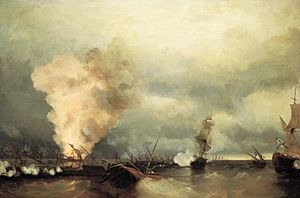| Battle of Vyborg Bay | |||||||
|---|---|---|---|---|---|---|---|
| Part of the Russo-Swedish War (1788–90) | |||||||
 Battle of Vyborg Bay, by Ivan Aivazovsky | |||||||
| |||||||
| Belligerents | |||||||
|
|
| ||||||
| Commanders and leaders | |||||||
|
|
| ||||||
| Strength | |||||||
21,000 men[2] (number of cannon and men does not include rowing craft) |
22 ships of the line[5]
40,000 seamen and soldiers including arch. landing party[e] | ||||||
| Casualties and losses | |||||||
The Battle of Vyborg Bay (or the Battle of Vyborg)[f] was a naval battle fought between Russia and Sweden on 3 July 1790 in Vyborg Bay off the coast of Vyborg during the Russo-Swedish War (1788–1790). The Swedish Navy suffered heavy losses, losing seven ships of the line and three frigates, but Gustav III of Sweden eventually ensured a Swedish naval escape through a Russian naval blockade composed of units of the Baltic Fleet, commanded by Admiral Vasily Chichagov.[11] British historians would later call the Battle of Vyborg Bay the "Baltic Trafalgar".[2] The battle ranks among the world's largest historical naval battles[not verified in body] and also among the most influential, as it introduced the naval battle concept of "firepower over mobility".[not verified in body]
Cite error: There are <ref group=lower-alpha> tags or {{efn}} templates on this page, but the references will not show without a {{reflist|group=lower-alpha}} template or {{notelist}} template (see the help page).
- ^ a b Егоршина 2023, p. 184.
- ^ a b c d e f g h "Vyborg and Rochensalm (The History of Russian Navy)". Archived from the original on 14 April 2012. Retrieved 27 October 2011.
- ^ Выборгское сражение 1790 : [арх. 2 декабря 2022] / А. А. Потехин // Восьмеричный путь — Германцы. — М. : Большая российская энциклопедия, 2006. — С. 106. — (Большая российская энциклопедия : [в 35 т.] / гл. ред. Ю. С. Осипов ; 2004—2017, т. 6).
- ^ Грибовский В. Ю. Выборгское сражение 21—23 июня 1790 г. Terijoki.spb.ru (1993). Дата обращения: 6 декабря 2020.
- ^ a b c d e f g h i j k l m Выборгское морское сражение // Sytin Military Encyclopedia. Vol. 7: "Воинская честь — Гимнастика военная", pp. 99—101
- ^ Novikov 1948, p. 140.
- ^ a b Sozaev E., Tredrea J. Russian Warships in the Age of Sail 1696-1860: Design, Construction, Careers and Fates. Seaforth Publishing. 2010. P. 67
- ^ Леер Г. А. (ред.) Энциклопедия военных и морских наук. СПб. Т. II. 1885. С. 341
- ^ Шопотов К. А. Выборгское морское сражение (к 210-летию) // Страницы Выборгской истории. Т. I. 2000. С. 158
- ^ a b Mattila (1983) p.208
- ^ Novikov 1948, p. 141.
Cite error: There are <ref group=NB> tags on this page, but the references will not show without a {{reflist|group=NB}} template (see the help page).